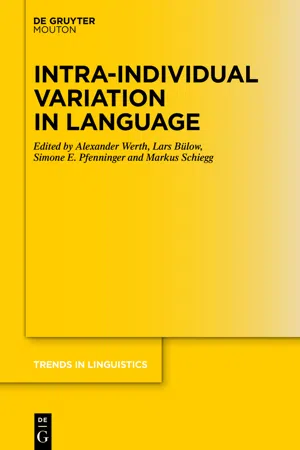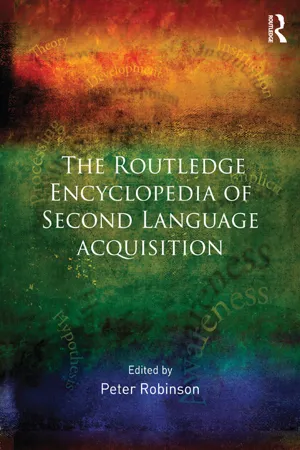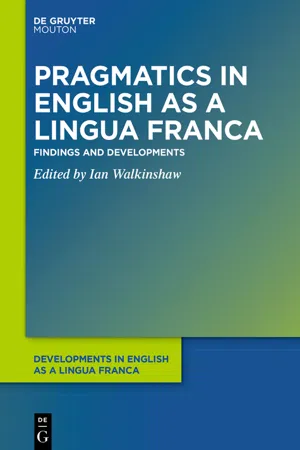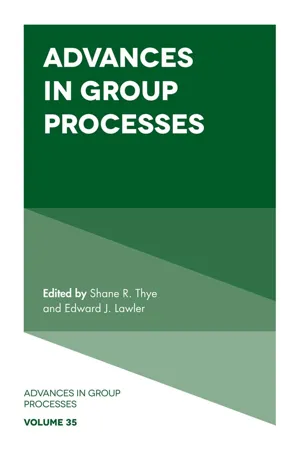Languages & Linguistics
Phonetic Accommodation
Phonetic accommodation refers to the tendency of individuals to adjust their speech patterns to match those of their conversation partners. This can involve changes in pronunciation, intonation, and speech rate. Phonetic accommodation is a natural and often subconscious process that occurs during communication, and it can help to facilitate social interaction and understanding between speakers.
Written by Perlego with AI-assistance
Related key terms
Related key terms
1 of 4
Related key terms
1 of 3
6 Key excerpts on "Phonetic Accommodation"
- eBook - ePub
- Alexander Werth, Lars Bülow, Simone E. Pfenninger, Markus Schiegg, Alexander Werth, Lars Bülow, Simone E. Pfenninger, Markus Schiegg(Authors)
- 2021(Publication Date)
- De Gruyter Mouton(Publisher)
This paper presents the results of an analysis of production data obtained from twelve female native Spanish learners of L2 German recorded during a collaborative map-task in order to investigate Phonetic Accommodation. Phonetic Accommodation is a process by which speakers increasingly select variants produced by an interlocutor in conversation. The focus of the study is on the realisation of neutralisation of final voicing contrast in plosives, a process found in German but not in Spanish according to existing contrastive analysis. Two main objectives were pursued in the study: (i) whether Phonetic Accommodation varies depending on the proficiency level of the participants as well as that of the interlocutor and (ii) whether individual subsegmental characteristics are affected differently. The findings show that both proficiency level and interlocutor influence the degree of accommodation. The findings also reveal that not all analysed subsegmental cues show comparable accommodation effects, and that the realisation of individual subphonemic cues leads to a high degree of inter- and intra-speaker variation. The greatest accommodation effects were found in conversations of highly proficient, non-native participants with a native speaker of German but also with a highly proficient non-native interlocutor. Participants with lower proficiency levels showed comparatively fewer accommodation effects. The degree of intra-individual variation seems to vary depending on proficiency level, in that the distribution of target-like and non-target-like realisations differs between L2 speakers of high and low proficiency. However, both target-like and non-target-like realisations occur in the speech samples of all L2 speakers.Keywords: Phonetic Accommodation, neutralisation of final voicing contrast, proficiency level, collaborative map-task,1 Introduction
Intra-individual variation (IAV) in the realisation of phonetic details or subphonemic cues as well as in the representation of phonological categories has frequently been documented in interactions of multilingual individuals (cf. Flege 1995 ; Fabiano-Smith et al. 2010 ; Jiang 2010 ). Such variation can occur because of automatic and spontaneous or intentional and conscious imitation of perceived characteristics in an interlocutor’s or a model speaker’s speech. That means the individual produces different variants in the course of a single conversation resulting from perceptually guided changes in speech production. The variation occurs at any level of speech production and is referred to as speech accommodation (or simply accommodation) (e.g. Tobin et al. 2017 ). Phonetic Accommodation is a subset of speech accommodation that considers accommodation effects at the phonetic level only. A specific case of Phonetic Accommodation is phonetic drift (Sancier and Fowler 1997 ), referring to cross-language effects resulting from exposure to a language that an individual is familiar with but not constantly using.1Within the field of language acquisition, a phenomenon might be considered a macro-level of accommodation when interlocutors consciously or unconsciously switch the entire language because of insufficient proficiency or volitional discourse strategies in multilingual communications. In addition to psycholinguistic aspects and aspects of communication design, grammatical constraints permitting or prohibiting language switches within and across sentences have also been previously investigated (cf. Myers-Scotton 2002 ; Clyne 2003 ; Riehl 2014 ; Müller 2017 ). The type of accommodation that is the focus of the present chapter may be considered the micro-level of accommodation. It is concerned with individual linguistic aspects, which have been attested on all linguistic levels (e.g. for syntax see Bock 1986 ; Gries 2005 ; for morphology see Trudgill 1986 ; Dunstan 2010 ; for semantics (and pragmatics) see Heim 1992 ; Beaver and Zeevat 2007 ; Liberman 2012 ; for lexical choice see Van Baaren et al. 2003 ; Jacob et al. 2011 ; for phonetics and phonology see Sancier and Fowler 1997 ; Pardo 2006 ; Nilsenová et al. 2009 ; Fabiano-Smith et al. 2010 ; Chang 2013 ; Pardo et al. 2013 ; Tobin et al. 2017 - Peter Robinson(Author)
- 2012(Publication Date)
- Routledge(Publisher)
A DOI: 10.4324/9780203135945-1 Accommodation KimMarie Cole SUNY Fredonia In the field of socio-linguistics, accommodation is valued for its explanations and predictions of individual variation. As described below, second language acquisition (SLA) researchers have used accommodation to account for differences in learners’ language use with native speakers and how it accounts for some linguistic features of input. While empirical studies are relatively few in number, Tarone’s (2007) review includes accommodation among sociolinguistic theories of SLA. Beebe and Giles (1984) first present an overview of Speech Accommodation Theory (SAT) and its applications to second language acquisition. Its key propositions include convergence and divergence, active strategies used by learners based on their assessment of the perceived relationship between their language and that of their interlocutors. When speakers like or identify with their speakers or have an instrumental purpose for speaking, their speech converges. They are likely to model their speech on that of their interlocutor, using similar linguistic features. Conversely, when speakers feel a lack of identification or a perceived threat to their language, they accentuate linguistic differences, or diverge from their interlocutors. In terms of SLA, the model suggests that those learners who perceive the new language as a threat to their first language would not seek opportunities to practice the second and would therefore not develop second language proficiency. Conversely, learners, who see the second language as complementary to their first would achieve higher proficiency- eBook - ePub
Pragmatics in English as a Lingua Franca
Findings and Developments
- Ian Walkinshaw, Ian Walkinshaw(Authors)
- 2022(Publication Date)
- De Gruyter Mouton(Publisher)
Analysis of my subsequent data continued to demonstrate the same phenomenon regardless of the first languages of the interlocutors, the task type, the topic, or even how many were present in the interaction. We will return below to this early ELF accommodation research (published in Jenkins 2000) and consider some of the data. Suffice it to say for now that later accommodation research outside phonology did not necessarily show the same tendency to accommodate by reverting to target forms. It may therefore still be an empirical question as to whether phonological accommodation operates differently from accommodation at other linguistic, and particularly pragmatic, levels in ELF settings.But before we continue with accommodation in ELF communication, as some readers may be unfamiliar with accommodation theory, I will provide a brief account of its beginnings in social psychology, the earlier phases of its pioneers’ theorising and research, and the various strategies and motivations involved in the phenomenon.2 Accommodation: The beginnings and development of the theory
Accommodative behaviours, particularly convergence (making one’s speech more like that of an addressee) and divergence (the opposite), were in fact theorised several decades ago, beginning with the work of Giles initially working alone and subsequently with various colleagues. In its original form, Speech Accommodation Theory, or SAT, the theory aimed to account for the affective and cognitive motivations underlying the adjustments speakers make when they converge on or diverge from the speech of their interlocutors. The goals of these adjustments were thought to be one or more of these three: evoking an interlocutor’s social approval, promoting communicative efficiency among interlocutors, and maintaining a positive social identity (see Beebe and Giles 1984 for a full discussion). In order to converge, individuals were said to adapt to an interlocutor’s speech in respect of a range of linguistic and prosodic features including pronunciation, utterance length, pause, and speech rate. By contrast, in order to diverge, they might, for example, use pronunciation features distinctive to themselves and their own linguistic/cultural peer group, or even switch to another language. - eBook - ePub
- Shane R. Thye, Edward J. Lawler(Authors)
- 2018(Publication Date)
- Emerald Publishing Limited(Publisher)
In this paper, we review theory and research linking patterns of vocal accommodation to individuals’ locations within small group status and power structures. We begin with an overview of the central concepts and processes involved in behavioral convergence and vocal accommodation. Second, we discuss theoretical and empirical work connecting vocal accommodation to actors’ relative position within interactional hierarchies of power and prestige. Third, we outline a number of future directions for research in this area, highlighting currently unanswered questions about the relationship between structural location and vocal accommodation as well as the need for further testing of existing arguments. Finally, for readers interested in researching vocal accommodation, we describe the most common procedures for collecting and analyzing vocal spectral data. Our goal is to encourage group processes’ scholars to take up vocal accommodation measures as they seek to address current research questions and open new lines of social psychological inquiry.TEMPORAL SYMMETRY AND THE RHYTHM OF INTERACTION
The process of vocal accommodation is rooted in a seemingly universal component of communication – interactional synchrony (Condon & Sander, 1974 ). Across a variety of contexts, social interaction frequently possesses a powerful rhythmic component (Condon & Sander, 1974 ; Kalkhoff, Dippong, & Gregory, 2011 ). Whether we consider friends sitting in a coffee shop who seem to spontaneously take a drink at the same time, or a group of unacquainted runners who intuitively find a common stride as they race together, even casual observation reveals that interaction can generate a rhythm that coordinates the behaviors of all those involved (Gregory, 1990 ). This apparently nonconscious synchronization of speech and behavior over time is temporal symmetry (Zerubavel, 1981 - eBook - ePub
- Rebecca Pozzi, Tracy Quan, Chelsea Escalante, Rebecca Pozzi, Tracy Quan, Chelsea Escalante(Authors)
- 2021(Publication Date)
- Routledge(Publisher)
Bucholtz & Hall, 2004 , p. 383). Speakers use language to establish with their interlocutors the particular relations that they desire.Linguistic accommodation is, therefore, a complicated social behavior, driven by issues of identity, relationships, ethnicity, and the temporal and spatial particularities not only of the interaction but also of moments considered important to the interlocutors. SA offers a context in which accommodation to the local language, and the reasons for it, may be examined.Study abroad in Spain
Spain is the third most-visited SA destination among US students (Institute of International Education, 2018 ), and a number of studies have examined their experiences there. Results are mixed as to whether or not SA students accommodate to Peninsular Spanish. These studies examine learners’ accommodation to phonological and morphological features (/θ/, /χ/, and vosotros).The interdental fricative /θ/ is salient in Peninsular Spanish, which should make it especially susceptible to accommodation (e.g., Trudgill, 1986 ). However, L2 students tend not to use it. In research by Geeslin and Gudmestad (2008) , nine out of 130 participants produced the variant in a monologic role-play task. Their rate of [θ] ranged from 8% to 100% in the task. Of the 209 contexts in which it could have been used in a study by Ringer-Hilfinger (2012) , it was produced six times. Seven out of 15 participants in a study by Knouse (2013) produced [θ], but at low rates (36/2,119 occurrences across the group). The highest rate of [θ] production in a study by George (2014) was 30%, but the majority of her participants produced it 2% of the time. Of Pope’s (2016) four participants, two accommodated to [θ], one used it half of the time, and the fourth avoided it. Accommodation was observed in students who had more social connections with Spaniards, whereas students with more Latin American connections avoided the phoneme. The uvular fricative /χ/ has shown similar results. The majority of George’s (2014) - eBook - ePub
- Margaret McLaughlin(Author)
- 2012(Publication Date)
- Routledge(Publisher)
perception of the other’s speech that will determine his or her evaluative and communicative responses.But, before proceeding perhaps we should ask: Are the various phenomena encompassed by speech accommodation worth theorizing about? What importance attaches to speech accommodation processes? Briefly, it is clear to us that the various forms of convergence and divergence can have important psychological and communicative consequences. For example, dialect divergence can increase or enhance the diverger’s sense of social identity (Bourhis & Giles, 1977). Or, to give another example, convergence to another’s dialect can lead persons to attribute to the converger the traits of friendliness, warmth, and so on (Coupland, 1985). And, of course, attributed personality characteristics can affect the attributer’s subsequent interactions with the converger. So it seems to us that understanding the structures and processes implicated in speech accommodation is a worthwhile goal. And not only are accommodation phenomena potentially consequential, they are ubiquitous; they pervade human interaction.The theory has been developed via a number of social psychological principles. Speech convergence is considered primarily in terms of similarity attraction (Byrne, 1969), causal attribution (Heider, 1958), and speech divergence with respect to intergroup processes (Tajfel & Turner, 1979). Consideration of these principles allows for explication of both the intentions thought to underlie speech shifts and the evaluations of them. This chapter presents an overview of the two speech strategies, convergence and divergence, with respect to antecedent motives and evaluative consequences. Speech convergence will be considered in terms of desire for social approval, situational constraints on its occurrence and evaluation, observers’ causal attributions that may be invoked to account for it, as well as the level of awareness necessary for its inception. Speech divergence, which has been explored empirically less often, is considered in terms of the interactional functions, identity maintenance, and cognitive organization (see Giles, Scherer, & Taylor, 1979). The chapter concludes with a more complete and refined set of SAT propositions than hitherto proposed relating to the determinants, functions, and social consequences of speech shifts. Yet it does more than this, as the latter also are reformulated in such ways as to take into account the theoretical implications of current research in some other relevant but independent areas of inquiry, particularly those of self-presentation and couple identity. Finally, some new theoretical and methodological priorities for the future are proposed.
Index pages curate the most relevant extracts from our library of academic textbooks. They’ve been created using an in-house natural language model (NLM), each adding context and meaning to key research topics.
Explore more topic indexes
Explore more topic indexes
1 of 6
Explore more topic indexes
1 of 4





